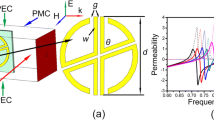Abstract
The split-ring resonator (SRR) arrays are commonly used to form a negative refractive index metamaterial that exhibits an effective negative permeability. However, the region of negative permeability obtained by SRR unit cell is generally limited to a narrow bandwidth at a fixed frequency. In this paper, we present a tunable metamaterial based on multi-split-ring resonators (MSRR) with MEMS switch components to realize controllable magnetic resonant frequency. Numerical simulations are performed to validate the proposed theory and tunability. The simulated results show that the MSRR structure metamaterial can realize digital tuning mode and continuous tuning mode by controlling state and height of MEMS switch components, respectively. Moreover, the simulated results are consistent with the theoretical results, which verify that the proposed theory is effective in prediction and analysis of magnetic resonant frequency. Therefore, such a tunable metamaterial can be reconfigured into a variety of states for use in different applications.






Similar content being viewed by others
References
Aydin K, Ozbay E (2007) Capacitor-loaded split ring resonators as tunable metamaterial components. J Appl Phys 101:024911
Caloz C, Itoh T (2006) Electromagnetic metamaterials: transmission line theory and microwave applications. Willey, Hoboken
Chen X, Grzegoczyk TM, Wu B, Pacheco IJ, Kong JA (2004) Robust method to retrieve the constitutive effective parameters of metamaterials. Phys Rev E 70:016608–016615
Gil M, Damm C, Giere A, Sazegar M, Bonache J, Jakoby R, Martin F (2009) Electrically tunable split-ring resonators at microwave frequencies based on barium-strontium-titanate thick films. Electron Lett 45(8):1362
Han JG, Lakhtakia A, Qiu CW (2008) Terahertz metamaterials with semiconductor split-ring resonators for magnetostatic tenability. Opt Express 16(19):14390
Liu N, Guo HC, Fu LW, Kaiser S, Schweizer H, Giessen H (2008) Three-dimensional photonic metamaterials at optical frequencies. Nat Mater 7(1):31–37
Lv JH, Hu XW, Liu MH, Yan BR, Kong LH (2009) Negative refraction of a double L-shaped metamaterial. J Opt A Pure Appl Opt 11:085101
Melik R, Unal E, Perkgoz NK, Puttlitz C, Demir HV (2009) Flexible metamaterials for wireless strain sensing. Appl Phys Lett 95:181105
Ozbay E, Aydin K, Butun S, Kolodziejak K. and Pawlak D (2007) Ferroelectric based tuneable SRR based metamaterial for microwave applications. Proceedings of the 37th European Microwave Conference (EuMA), pp 497–499
Penciu RS, Aydin K, Kafesaki M, Koschy T, Ozbay E, Econmou EN, Soukoulis CM (2008) Multi-gap individual and coupled split-ring resonator structures. Opt Express 16(22):18131–18144
Rebeiz GM (2003) RF MEMS-Theory, Design and Technology. Wiley, New York
Shelby RA, Smith DR, Schultz S (2001) Experimental verification of a negative index of refraction. Science 292(5514):77–79
Shen NH, Kafesaki M, Koschny T, Zhang L, Economou EN, Soukoulis CM (2009) Broadband blueshift tunable metamaterials and dual-band switches. Phys Rev B 79:161102
Simovski CR, Belov PA, He S (2003) Backward wave region and negative material parameters of a structure formed by lattices of wires and split-ring resonators. IEEE Trans Antenna Propag 51(10):2582–2590
Smith DR, Padilla WJ, Vier DC, Nemat-Nasser SC, Schultz S (2000) Composite medium with simultaneously negative permeability and permittivity. Phys Rev Lett 84:4184–4187
Smith DR, Vier DC, Koschny Th, Soukoulis CM (2005) Electromagnetic parameter retrieval from inhomogeneous Metamaterials. Phy Rev E 71:036617–036628
Veselago VG (1968) The electrodynamics of substances with simultaneously negative values of ε and μ. Sov Phys Usp 10:509–514
Wang DX, Ran LX, Chen HS, Mu MK (2007) Active left-handed material collaborated with microwave varactors. Appl Phys Lett 91:164101
Wang FJ, Qu SB, Xu Z, Ma H, Gu C (2008) A controllable magnetic metamaterial: split ring resonator with rotated inner ring. IEEE Trans Antenna Propag 56(7):2018–2022
Wang J, Qu S, Zhang J, Ma H, Yang Y, Gu C, Wu X (2009) A tunable left-handed metamaterial based on modified broadside-coupled split-ring resonators. Prog Electromagn Res Lett l6:35–45
Yao Y, Fu QH, Zhao XP (2009) Three-level dendritic structure with simultaneously negative permeability and permittivity under normal incidence of electromagnetic wave. J Appl Phys 105:024911
Zhang FL, Kang L, Zhao Q, Zhou J, Zhao XP, Lippens D (2009) Magnetically tunable left handed metamaterials by liquid crystal orientation. Opt Express 17(6):4360–4366
Zhao Q, Kang L, Du B, Li B, Zhou J (2007) Electrically tunable negative permeability metamaterials based on nematic liquid crystals. Appl Phys Lett 90:011112
Acknowledgment
The work is supported by the National Natural Science Foundation of China (51005001), the China Postdoctoral Science Foundation (20090450226), the Research Foundation of Education Bureau of Heilongjiang Province (11551098) and Youth Foundation of Harbin University of Science and Technology (2009YF024).
Author information
Authors and Affiliations
Corresponding author
Rights and permissions
About this article
Cite this article
He, X., Lv, Z., Liu, B. et al. Tunable magnetic metamaterial based multi-split-ring resonator (MSRR) using MEMS switch components. Microsyst Technol 17, 1263–1269 (2011). https://doi.org/10.1007/s00542-011-1313-z
Received:
Accepted:
Published:
Issue Date:
DOI: https://doi.org/10.1007/s00542-011-1313-z




